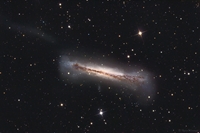|
|
Dust dimming our universeAstronomers have found that our universe shines twice as bright as thought.
Provided by the STFC, United Kingdom
Published:
May 16, 2008 Galaxy NGC 3628 is known to have dust obscuring its stars.
Photo by Russell Croman
Astronomers
from UK universities, working with colleagues from Germany and
Australia, have calculated that the universe is actually twice as bright
as previously thought. In the May 10th Astrophysical Journal Letters, the astronomers describe how dust is obscuring approximately half of the light that the universe is currently generating.
Lead
author Simon Driver from the University of St Andrews says, "For nearly
2 decades we've argued about whether the light that we see from distant
galaxies tells the whole story or not. It doesn't; in fact only half
the energy produced by stars actually reaches our telescopes directly,
the rest is blocked by dust grains."
While astronomers have known
for some time that the universe contains small grains of dust, they had
not realized the extent to which this is restricting the amount of
light that we can see. The dust absorbs starlight and re-emits it,
making it glow. They knew that existing models were flawed, because the
energy output from glowing dust appeared to be greater than the total
energy produced by the stars!
Driver says, "You can't get more
energy out than you put in so we knew something was very wrong. Even so,
the scale of the dust problem has come as a shock appears that galaxies
generate twice as much starlight as previously thought."
The
team combined an innovative new model of the dust distribution in
galaxies developed by Cristina Popescu of the University of Central
Lancashire and Richard Tuffs of the Max Plank Institute for Nuclear
Physics, with data from the Millennium Galaxy Catalogue, a
state-of-the-art high resolution catalogue of 10,000 galaxies assembled
by Driver and his team using the Isaac Newton Telescope on La Palma
among others.
Using the new model, the astronomers could
calculate precisely the fraction of starlight blocked by the dust. The
key test that the new model passed was whether the energy of the
absorbed starlight equated to that detected from the glowing dust.
"The
equation balanced perfectly," says Popescu, "and for the first time we
have a total understanding of the energy output of the universe over a
monumental wavelength range."
"The results demonstrate very
clearly that interstellar dust grains have a devastating effect on our
measurements of the energy output from even nearby galaxies," says
Tuffs, "with the new calibrated model in hand we can now calculate
precisely the fraction of starlight blocked by the dust."
The
universe is currently generating energy, via nuclear fusion in the cores
of stars, at a whopping rate of 5 quadrillion watts per cubic
light-year—about 300 times the average energy consumption of
the Earth's population.
"For over 70 years an accurate
description of how galaxies, the locations where matter is churned into
energy, form and evolve has eluded us. Balancing the cosmic energy
budget is an important step forward," says Driver.
After
carefully measuring the brightness of thousands of disc-shaped galaxies
with different orientations, the astronomers matched their observations
to computer models of dusty galaxies. From this they were able to
calibrate the models and, for the first time, determine how much light
is obscured when a galaxy has a face-on orientation. This then allowed
them to determine the absolute fraction of light that escapes in each
direction from a galaxy.
While modern instruments allow
astronomers to see further into space, they can't eliminate the
obscuring effect from these tiny dust grains. "It is somewhat poetic
that in order to discover the full glory of our Universe we first had to
appreciate the very small," says Alister Graham from the Swinburne
University of Technology.
The work is set to continue but with a
change of focus from the study of the universe as a whole, to the study
of individual galaxies. This requires two new facilities that are coming
online this year. The first is the VISTA telescope, which will soon
commence operations in Chile and the second is the Herschel satellite
due for launch later in the year.
"VISTA will enable us to see
right through the dust while Herschel will directly detect the dust
glow," says Jochen Liske of the European Southern Observatory.
"Although
the universe appears to be squandering its resources twice as fast as
we previously thought, there's still plenty of juice in the tank; for
now," says Ivan Baldry of Liverpool John Moores University. |
 
|
 |
Look for this icon. This denotes premium subscriber content.
Learn more » |
Receive news, sky-event information, observing tips, and more from Astronomy's weekly e-mail newsletter
|